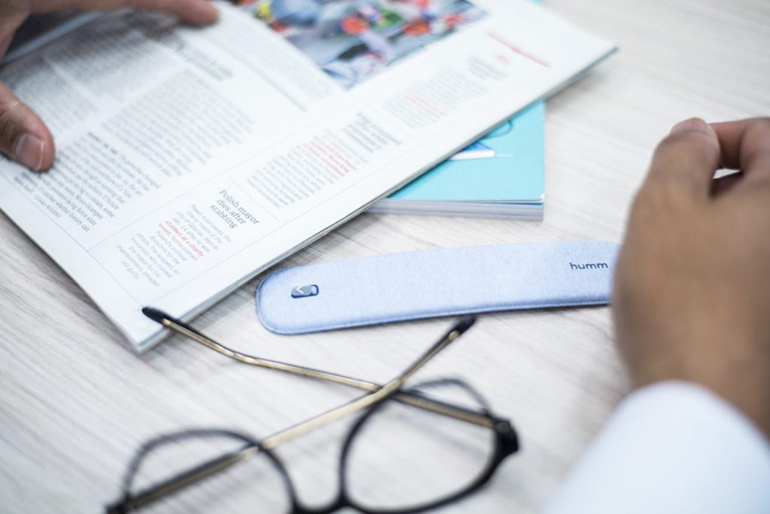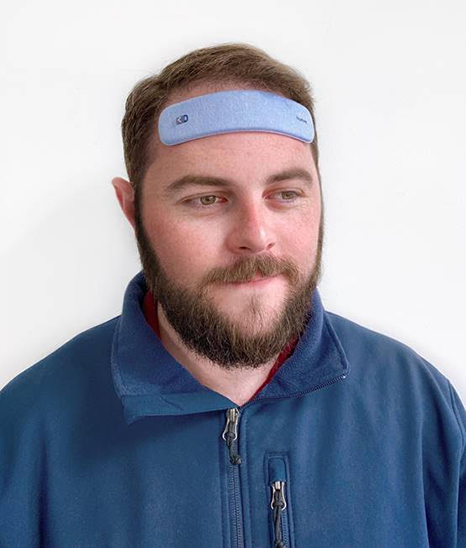
We previously interviewed Humm, a San Francisco-based neuroscience company, when they had first released their Edge headset – an electrical stimulation device that helped users by boosting their working memory. Humm is focused on helping people continue to learn and grow throughout their lives. The idea behind their innovations is that through stimulation of the prefrontal cortex—a crucial area of the brain for decision making and learning—people’s ability to process and store information will be improved. Humm uses a safe and proven method of electrical stimulation called tACS (transcranial alternating current stimulation) that is informed by 30 years of scientific research.
In an increasingly fast-paced and competitive world, researchers have been exploring electrical brain stimulation as a way to enhance our cognitive abilities at the flick of a switch. People think nothing of using a stimulant such as coffee to improve their concentration and energy levels, but chemical stimulants can have side-effects such as sleep disturbance. The goal of electrical brain stimulation is to enhance performance of cognitive tasks without the side-effects of medication.
As the first of its type, Humm has adapted their headset technology into a new lightweight and comfortable form factor, at a price that is comparable to the price of a cup of coffee. The wearable patch can immediately improve a person’s working memory so that they learn faster. Other consumer neurostimulation devices, such as Halo Sport 2, targets other areas of the brain and focuses on movement-related tasks via stimulation of the motor cortex.
Humm’s patch resembles an adhesive bandage that provides a boost to the prefrontal cortex when applied to the forehead. Similar to a conductor using a tuning fork to tune an orchestra, the patch emits a finely tuned tiny electric pulse that ripples throughout the brain and encourages neurons to resonate together at the same frequency. This helps more parts of the brain to be temporarily connected and primed to process new information, immediately improving working memory and ability to learn. In tests, this phenomenon was shown to be sustained for up to an hour and a half following treatment.
In a successful randomized trial recently conducted at UC Berkeley’s SkyDeck accelerator, the Humm patch replicated the benefits that were first measured decades ago in peer-reviewed research at the world’s top research institutions. Forty subjects were measured for the effects of the device on working memory in comparison to a placebo, where results showed a 20% improvement in the volume of information that a person could hold in their working memory for several hours by the tuning of the activity in the prefrontal cortex. This represented an acceleration of the speed at which a user could learn the task involved by 120 times compared to the placebo (see Humm White Paper).
The trial was designed and conducted with oversight and statistical analysis from Humm’s scientific advisory board, which includes Dr. Ted Zanto, Director of Neuroscience at the UCSF Neuroscape lab, and Dr. Vivienne Ming, internationally renowned neuroscientist and founder of Socos Labs.
Many businesses and organizations have taken notice of Humm’s technology. This includes the United States Air Force recently ordering their first thousand patches for use in an upcoming clinical trial in its training academy.

The patch is made from environmentally-friendly fabrics, gels, and innovative disposable battery technology. Humm’s patch will be available to purchase in packs, or on a discounted monthly subscription. Users receive 12 patches for $ 60 or $ 5 per patch each month. It’s easy to put on, like a sticker, and takes seconds to set up.
Humm’s wearable patch is available for pre-order to the public now with delivery in early 2020 through their website, www.thinkhumm.com.
We had a chance to interivew Iain McIntyre, the CEO and co-founder of Humm, to find out more about the company’s technology and where it is going to be applied.
Alice Ferng, Medgadget: Great to chat with you! Tell me about Humm’s new patch and how it’s different from products of other similar companies out there in the same space.

Iain McIntyre, CEO and Co-founder of Humm: One of the interesting things about my company is that we are focused on bigger use cases than what’s come from consumer technologies before. Obviously, medical products are confined to particular indications, and then it involves insurance and such. Then there have been other consumer companies, such as Halo, that I think we’ve learned from. One way is that we are doing something scientifically that seems to be more efficacious with broader cognitive learning that can be assessed as a benefit for people in a broader group outside of the professional sports organizations. Then there was the stress product idea that didn’t seem to work as well in the current iterations.
So the other really big thing that we are doing is making the technology about a hundred times cheaper to actually use the technology. Really re-packaging the technology that has been around – which is now fairly well understood, although it is a developing science – into something that people can actually use. Making it intuitive enough for people to actually want to use and keeping it convenient in a really small form factor that comes in a box with a couple of them. It’s also a lot less intimidating to people in this way. It’s not a rechargeable big strap thing on your head. And it’s cheap enough that you can want to try it without having to buy the coffee machine to try the coffee; you can just buy the coffee. What we’re finding is that people really like that they can use the device a couple of times per patch, and it typically works between 1-3 times depending on the duration of each session. It is pretty convenient to carry around without needing a big headphone case, or anything like that.
Medgadget: What are the biggest changes from your headband to the current product? What prompted the form factor change, and what were the challenges you had to overcome?

Mr. McIntyre: So throughout this interview, I’m also going to refer to Halo – I actually really like what they do because it’s good work, backed by science. However, one of the larger problems of this industry is that so far the device expected has been seen as a bit scary by the general population. A lot of the products have targeted particular people, such as biohackers, who are easy to sell to because they’re not the kind of people who are really worried about looking like a freak or anything like that. But for this technology to become mainstream and to actually be really useful to people as it deserves to be (and also, people deserve to be able to use it), it does need to be able to overcome these barriers, and that’s what Humm is targeting.
As a result, some of the reasons Humm has moved away from the headband is what I just mentioned: to make it look less scary, be more convenient, less bulky, reusable, and affordable.
The other reasons were some of the things that we identified we wanted to fix about the technology. These insights came out of a big consumer study that we did. We had made 40 of those Edge headbands you have seen previously and cycled through groups of people – distributing the technology to about 120 customers in total. We looked from older people to younger people, across different use cases such as studying, all the way to cooking dinner. And we really tried to identify the places where the technology was the most useful and would be suit those people and use cases.
Some of the things we identified really actually support the work that other companies such as Halo do, but we also really focused on some of the things really stopping this technology from becoming more useful for people.
The first barrier is just that it’s expensive to try this type of technology. Unlike other devices designed for sleep or sports performance enhancement, which may cost as much as $ 10,000 for a lab research model or $ 500 for consumer versions, the new easy-to-use Humm patch is available for about $ 5 apiece, making it extremely easy for people to simply give it a try, rather than committing to an expensive investment. Again, why buy the expensive coffee machine when you can just try the coffee?
The other big thing is other than the expensive big, is that it’s just intimidating. A lot of the headsets are kind of Starship Enterprise-y (referring to Star Trek); so they’re big, and recharge on a wall, so people think it has a lot of electricity in them. And then they have these really aggressive looking sponges and things that you have to hook yourself up to. Then there’s the requirement that you have to really precisely strap this thing on the back of your head, and then it gets in your hair and such. It’s just intimidating and uncomfortable to use these products. And yeah, that’s where Halo has done one of the better jobs with some of these aspects. But unfortunately, you still need to wet the electrodes on your head and push down and stuff like that to make it work, and it takes everyone a few minutes to set it up. Then it is also bulky to carry around.
So these were the things that we identified and wanted to improve on. We wanted to make it intuitive and approachable, and as easy to use as a Band-Aid – so that’s what we built. It took us about 6 months of redoing the fundamental technology from the ground up – building the circuitry in a novel way and figuring out novel battery technology to make it work like that. Then making it really intuitive to just tear some pads off, then press a button, and then it works.
Medgadget: Who are your targeted customers, and what are the intended use cases?
Mr. McIntyre: The other big thing that we had to work on was making it familiar to people. I don’t think that anyone wants to buy a wearable for something they have never heard of before. For example, Fitbit wasn’t the first pedometer at all – it was 30 years of pedometers – but because it wasn’t something that people could really recognize, it took until the idea of a watch with many extra features for it to really catch on. That familiarity suddenly helped package these technologies for people. So for us, you would be receiving a box of a couple reusable products that can be thought of as very similar to a box of vitamins or pills. A box of Band-Aids is a very understandable thing for people to use since it’s just a little patch, and it’s not a wearable where you don’t know how it works. It’s convenient enough you can buy a single box, or get a subscription so that they come in a fresh supply, without having to worry about maintaining them or replacing parts. Then oftentimes, people want to share things with their friends, and this would be so easy to do.
We had the industrial designer who designed the first Fitbit and HTC Vive that collaborated as part of our big design team to help us think about how we could package it. It was the idea of packaging neurostimulation into a consumer wellness brand and building the pattern from the ground up so that it’s environmentally friendly and easy to use. Then there’s a couple benefits that we’re taking advantage of with the science as well.
We’re working on the prefrontal cortex, so we don’t have to go through the hair and can just put it on the forehead, which is great. Humm is targeted at people 40+ years old who are studying, reading unfamiliar material, or learning new skills.
Medgadget: Let’s get a little more technical in regards to the patch. How many points of contact are there? What’s the frequency, and why was that chosen? What’s the maximum output of the patch used to administer the tACS, and can you draw an analogy of power so that people aren’t afraid to put this on? Finally, with the placement of the patch on the forehead, what sensations can be felt by users?
Mr. McIntyre: It’s just got 2 points of contact where two sticky hydrogel patches adhere to your forehead. These are the same as the sticky hydrogels that have been used many years in muscle stimulators, such as the TENS machines. The patch is reversing an alternating current between the 2 points of contact, and it can hold 6 hertz (Hz).
We picked 6 Hz because it’s in the middle of the theta frequency, and there were a couple of studies before us that had used that specific frequency for stimulation. It’s just 1.5 to 2 milliamps (mA), which means we can tell customers that it’s a couple thousand times less electricity than what’s in their brain already.
For people who are scared of the electricity part, let’s put it this way: someone would need to stick on about 20 of our patches (1.5mA) at once in order to be exposed to even the minimum current that a common TENS machine would give you (30-80mA).
The sensations felt are pretty subtle and doesn’t hurt. I think one of the problems with other devices that go into the hair, onto the scalp, is that they tend to get quite prickly. I think the patch feels more like a tingle, and because of the placement you see a bit of subtle flashing, which is another interesting thing and some people love it, while others are just kind of ambivalent to it.
Medgadget: Can you talk about how the currents actually activate the brain? What are the main experiential differences between tDCS and tACS (e.g., direct vs. alternating current stimulation)?
Mr. McIntyre: The cool thing about applying stimulation to the prefrontal cortex is that we don’t have to worry too much about the placement as long as it is within about two inches of the site we show in our pictures, and this is based on our modeling and testing. As long as it’s placed around there, you’re getting 90%+ of the current into the “right” part of the brain. The way that the AC works is that it’s a resonance effect that’s an entrainment effect – instead of having to really precisely get a DC field into a part of the brain and worrying about it not having a full effect if it moves slightly. What we’re actually doing is causing the frontal part of the brain to resonate, and then that resonates throughout the brain, causing neurons to couple together in a circuit resonating at that peak Theta frequency, which is what causes the effect of the improved working memory for a couple hours.
Medgadget: Let’s dive into the science behind working memory and your brain as you age. Can you talk about that and also describe how the brain changes when you put on a patch?
Mr. McIntyre: So what we’re doing is boosting working memory. Working memory is something that deteriorates from the age of 12 on, and it’s such an important cognitive function. It becomes super impactful from the age of 40 onwards, and is something that you want a painkiller for. Prior to that, you kind of don’t realize deterioration is occurring, but it’s actually very natural. It’s something that everyone experiences and is one of those problems that is so fundamental to the human condition that we’ve all just accepted it.
When I think about that and what we’re doing – we aren’t really accepting that anymore. We’re wanting to remediate that to give people longevity of their quality of life – to continue being curious and being able to learn new things later in life by bucking that natural trend which our genetics has otherwise put us into.
The way that I explain working memory is like this. If you’re a scientist or computer person – it’s pretty easy just to say it’s the RAM of the brain. Like if you plug your USB drive into a computer and you try to download something to the hard drive or upload something, the working memory is kind of like the intermediary step that transports that information. For people who aren’t familiar, the human brain is this center point for all of the information sources coming in and just combining. That’s your sight, your touch, your eyes, etc. all sending information that ends up in a big jumble. What you pay attention to ends up in your working memory. If you can pay attention to it, you’ve only got so much capacity and then whatever you actually process and learn ends up in your long term memory. What you can pull out of your long term memory goes off to go into your working memory again.
What we do with the patch is to boost the size of that gate. We boost the size of the channel letting more information flow in and out. The way we do that electrically is similar to do conducting the orchestra of the brain’s neurons, where the brain is this billion-strong pot full of neurons with trillions of connections between them. So it’s really, really complicated since lots of electrical signals are going on and doing lots of things at once. But fundamentally, it’s just waves of electromagnetic energy, and those waves are reflective of whether you’re concentrating, asleep, and so on. What we do is artificially engineer, or cause a state to come about that is ideal for your memory. How we do that is by providing those neurons or that wave-y space with a conductor to give it structure, to make them play in time and play in tune. Those 6 Hz applied is kind of like dropping a stone in the middle that then resonates throughout the brain and causes more neurons to be connected.
The effects can be seen by sensors implanted under the skin, and it’s been shown that the electrical effects are sustained for a couple of hours afterwards. Not more than a day, and definitely not more than a week, but for a couple of hours. Of course, how long the effects last depends on the person and the targeted behavior – typically 30 minutes to 90 minutes. Notably, the effects are really short term. The electrical effect doesn’t cause any structural changes in the brain or chemical changes in the brain, and ultimately the electrical change dissipates pretty quickly within a couple of hours.
Product Impressions
Having had an opportunity to try one of the patches, it really was as easy as described; pull off the backing paper, place the patch on your forehead, and flick on a switch. I used the patch for 15 minutes, and within about 15-30 seconds, I noticed the phosphene sensations – kind of like a subtle flashing of light, since the patch is placed near your eyes (phosphene sensations occur from 10-40 Hz). Actually, if it weren’t for those phosphene sensations, I wasn’t too sure for the first few minutes that anything was happening. I wondered whether or not I had even turned on the device. However, after about 10 minutes, I started to feel something similar to a caffeine buzz; that feeling that you get when you feel a little bit more awake, energized, and focused. The company says that using the patch for just 15 minutes can provide certain cognitive enhancements for at least one hour. For me, I felt like this was definitely the case, and perhaps a bit longer than that.
Results from these types of products can be hard to quantify or even qualify. One way to think of one of these patches is as an aid. Let’s say you’ve invested a few hundred dollars in expensive running shoes for a marathon but have never trained for a marathon before. There’s only so much the shoes can help with, and after a while you would have diminishing returns. That’s why cognitive acuity and mental training has become increasingly popular topics over the past decade as we better understand that the brain is a muscle that needs to be exercised. But products such as Humm’s patch can help prime the brain in such a way to encourage better working memory and cognitive functions over time as you actively engage in mental tasks.
Link: Humm homepage…
